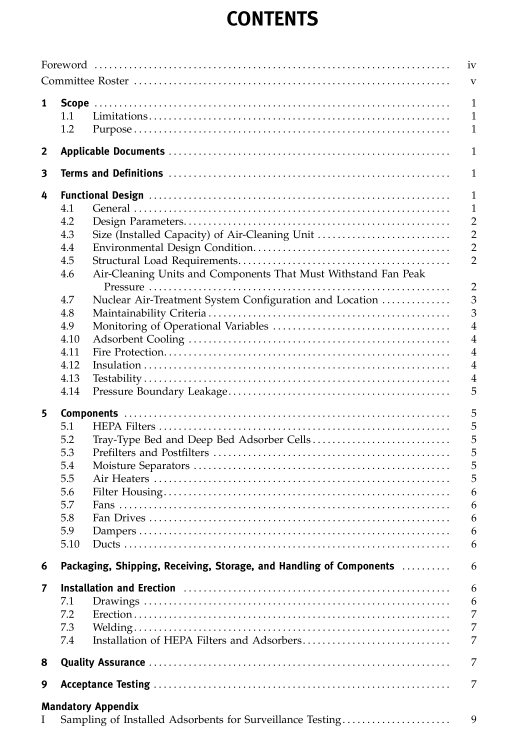ASME N509 pdf download

ASME N509 pdf download NUCLEAR POWERPLANT AIR-CLEANING UNITS AND COMPONENTS
4.3 Size (Installed Capacity) of Air-Cleaning Unit The installed capacity cfm (m 3 /hr) of the air cleaning unit shall be no greater than the limiting installed capacity of any bank of components contained in the aircleaning unit through which the airflow must pass. The 2 installed capacity of any bank or stage of components should not exceed the number of components in the bank times the rated capacity of the individual compo- nents. Test cannisters shall not be included in determin- ing the installed capacity of any bank or stage of adsorbers.
4.4 Environmental Design Condition All parts and components ofthe air-cleaning unitshall be selected or designed to operate under the environ- mental conditions (temperature, relative humidity, pres- sure, radiation, etc.) specified in para. 4.2. Materials of construction and components shallbe selected or treated to limit generation of combustibles and contaminants andtoresistcorrosionand degradationthatwouldresult in loss of function when exposed to the specified envi- ronmental conditions for the design life of the com- ponent. Environmental qualification requirements are con- tained in 10 CFR 50.49, IEEE 323 and ASME AG-1, Sec- tion AA and various specific ASME AG-1 Code sections.
4.5 Structural Load Requirements ESF systems and all of their components shall be shown, either by testing or by a mathematical technique, to remain functional under the structural loading speci- fied inASME AG-1,Article AA-4000 andvarious specific ASME AG-I Code sections.
4.6 Air-Cleaning Units and Components That Must Withstand Fan Peak Pressure The maximum design pressure shall be documented by calculation, including the basis for the condition, and included in procurement specifications for manufactur- er’s design.
(a) Positive Pressure. Air-cleaning units and compo- nents including ducts located on the discharge side of fan(s) which can be isolated by closure of a downstream damper, or potentially plugged components, shall be designed to withstand a positive internal pressure equal to or greater than the peak pressure of the fan(s). If provision is made to deenergize fan(s) on high differen- tial pressure or low flow, the components shall be designed to withstand the trip point design pressure plus a marginto include the rate ofpressure rise between reaching the pressure setpoint and the time for the instrumentation response, or 10%, whichever is greater.
(b) Negative Pressure. Air-cleaning units and compo- nents located on the inlet side of fan(s) which can be isolated by closure of an upstream damper, or poten- tially plugged components shall be designed to with- stand a negative internal pressure equal to or more negative thanthe peak pressure ofthe fan(s). Ifprovision is made to deenergize fan(s) onhigh differential pressure or low flow, the components shall be designed to with- stand the trip point design pressure plus a margin to include the rate of pressure rise between reaching the pressure setpoint and the time for the instrumentation response, or 10%, whichever is greater.
4.7 Nuclear Air-Treatment System Configuration and Location Physical location and arrangement of the components of a nuclear air-treatment system influence the require- ments for leak tightness for the various parts of the pressure boundary. Air flow should be from potentially less contaminated areas to potentially more contami- nated areas. Whenever possible, routing of contami- nated air through clean spaces or interspaces should be avoided. If this can not be done, the general guidance in this Section should be followed. Figures B-1410-1, B-1410-2, and B-1410-3 ofASME AG 1, Section SA schematically depict examples of possible combinations and location of fan and air-cleaning unit to minimize impact of system contaminated outleakage on surrounding clean spaces and interspaces as well as contaminated inleakage into a cleaner system component.
4.7.1 Effluent Nuclear Air-Treatment System (Once- Through)
(a) Maintain ducts conveying contaminated air through clean spaces or clean interspaces at a negative pressure with respect to the surrounding areas.
(b) With air-cleaning unit located in a clean interspace, locate exhaust fan downstream of air-clean- ingunitinorder to keep air-cleaningunitunder negative pressure. Any leakage through fan shaft will be from clean interspace.









